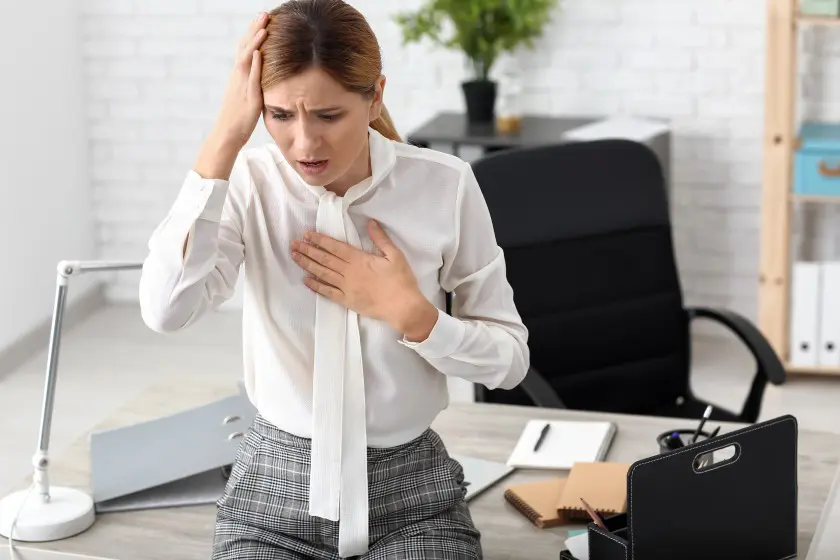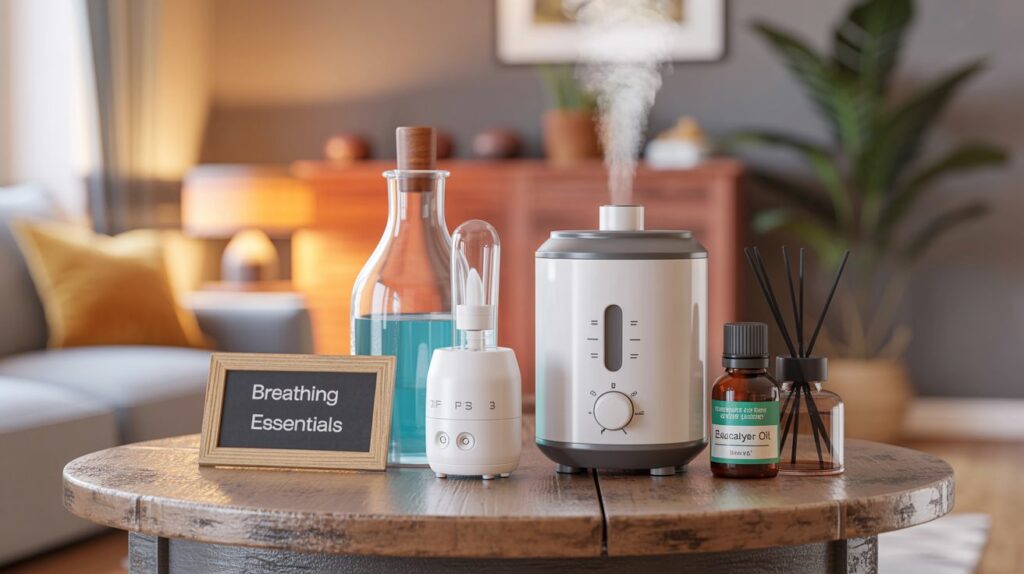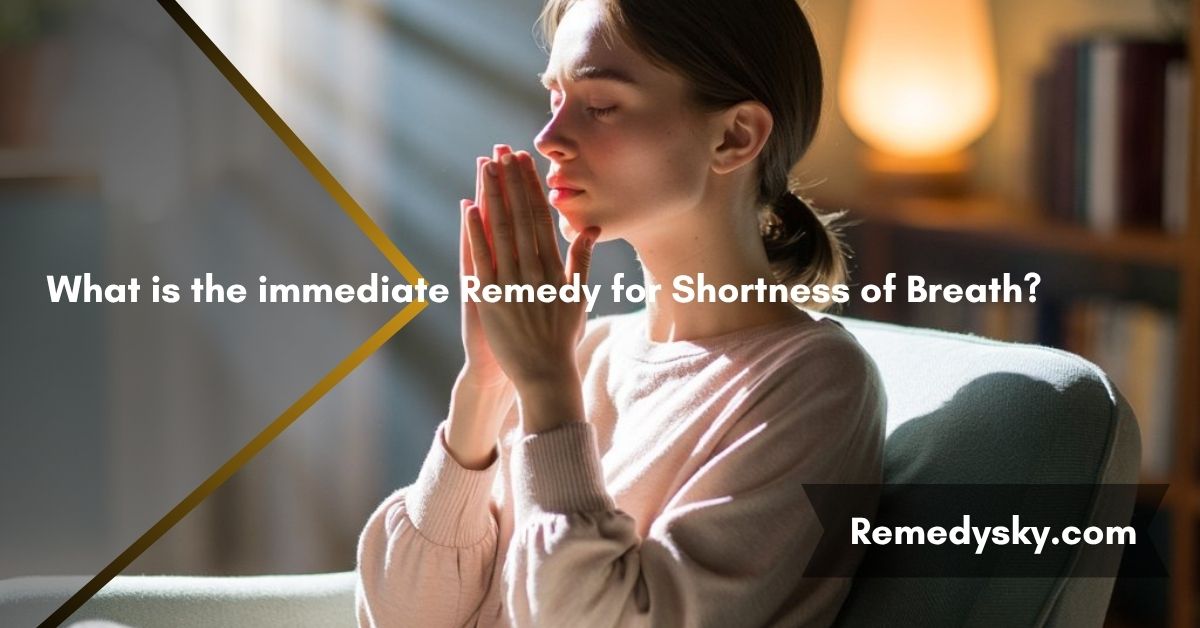When I suddenly felt out of breath, sitting up straight and practicing pursed-lip breathing immediately helped. It eased my anxiety and made breathing easier.
Sitting upright and using pursed-lip breathing to open your airways are the quick fixes for shortness of breath. By taking these little steps, you may relax and breathe more easily.
Stay tuned for more information as we explore the best way to treat shortness of breath right away. You’ll receive helpful hints, firsthand accounts, and recommendations supported by experts.
What to Do the Moment You Feel Breathless?
When you suddenly find yourself out of breath, you need to act promptly and calmly. In the first sixty seconds, you should do the following:
- Immediately stop exercising and take a nap.
- You can open up your chest cavity by sitting up straight or by bending forward a little.
- Tight belts, clothing, or items that can impede airflow should be loosened.
- Focus on your breathing and close your eyes if you’re feeling nervous.
- Start using a controlled breathing method, like pursed-lip breathing.
These methods assist reduce oxygen demand, alleviate airway pressure, and slow breathing pattern — crucial in controlling both physical and anxiety-induced dyspnea.
Breathing Techniques That Offer Instant Relief
Pursed-Lip Breathing
One of the best instant fixes, particularly for COPD, anxiety, and post-exercise dyspnea.
How to do it:
- Take a slow, two-second breath through your nose.
- Lips should be pursed as though you were going to whistle.
- For four seconds, release the breath evenly and gently through pursed lips.
- Repeat for 1–2 minutes or until symptoms improve.
Diaphragmatic Breathing
Often referred to as belly breathing, this method is perfect for increasing oxygen intake and decreasing shallow breathing.
How to go about it:
- Place one hand on your chest and one on your stomach while sitting or lying down.
- To make your stomach rise, take a deep breath through your nostrils.
- With pursed lips, release the breath as your stomach drops.
- Concentrate on extending the exhale.
This method is very effective for sleep apnea, asthma, and COPD.
Box Breathing (For Stress-Induced Breathlessness)
This method aids in regaining control during anxiety spikes or panic episodes.
How to do it:
- Take a 4-second breath.
- Hold for four seconds.
- Take a four-second breath out.
- Hold for four seconds.
- Do this four or five times.
It helps control breathing pattern and soothes the neurological system.
Best Body Positions for Fast Breathing Relief
By changing your position, you may instantly increase airflow and lessen the strain on your diaphragm and lungs.
Taking a Forward Seat
- Your feet should be flat on the ground as you sit in a chair.
- Slant forward a little.
- Your elbows should rest on a table or your knees.
- Keep your shoulders and neck relaxed.
Standing With Assistance
- Place your hips or back against a wall while you stand close to it.
- With your hands on a table or your thighs, slant slightly forward.
Sleeping in a Propped-Up Position
- Place a pillow between your legs and lie on your side.
- Use one or two cushions to keep your head up high.
- If you’re having trouble breathing, don’t lie down.
These postures ease the tension on your respiratory muscles and help your lungs expand.
Tailored Remedies Based on the Cause

Identifying the root cause of your dyspnea will enable you to employ the best treatment.
If It’s Due to Anxiety or Panic
- Start breathing with your lips pursed or in a box.
- Employ grounding exercises such as describing five objects you can see or holding an ice cube.
- Apply cool air to your face using a fan.
If It’s Due to Asthma
- If a rescue inhaler is recommended, use it.
- Instead of lying down, sit up straight.
- Steer clear of triggers such as chilly air, smoke, and dust.
If It’s Due to Physical Exertion
- Put an end to your activities and take a nap.
- Put your lips together and breathe.
- Drink cool water to stay hydrated.
If the Cause Is Unknown
- Do not panic. Remain motionless and composed.
- Take a seat forward and breathe deeply.
- Keep an eye out for any increasing symptoms, such as chest pain or lightheadedness.
When to Call a Doctor or Seek Emergency Help?
Home cures can be helpful, but some symptoms indicate that you need to see a doctor right away.
Call 911 or Emergency Help If:
- Suddenly, for no apparent reason, your breathing gets worse.
- You experience tightness, pressure, or chest pain.
- It causes your fingernails or lips to turn gray or blue.
- You feel lightheaded, faint, or confused.
- You get a wheeze or a choking sensation.
Avoid delaying emergency care since dyspnea may indicate a severe asthma attack, pulmonary embolism, or heart attack.
What Not to Do When You’re Breathless?
- Avoid lying flat since it prevents your lungs from expanding.
- It raises the demand for oxygen, so don’t panic.
- During acute bouts, don’t depend just on herbal steam or essential oils.
- If symptoms worsen or last for more than a few minutes, don’t disregard them.
Helpful Items to Keep at Home for Breathing Support

- Use a handheld fan to blow air into your face to alleviate dyspnea.
- Asthma rescue inhaler, if prescribed.
- CPAP machine (doctor-prescribed for sleep apnea).
- For better air quality, use a humidifier.
- Keep a symptom journal to monitor what causes dyspnea.
Prevention Tips to Avoid Future Episodes
- Avoid secondhand smoke and give up smoking.
- Low-impact activities like yoga or walking might help you stay active.
- Consume a well-rounded diet to keep your weight in check.
- Drink plenty of water to keep your airways hydrated.
- Reduce tension by doing breathing exercises or meditation.
- Avoid being outside in places with a lot of pollution.
- For chronic conditions like COPD or asthma, adhere to your doctor’s recommended course of therapy.
FAQs:
1. What is the most effective short-term treatment for dyspnea?
The best immediate treatments are sitting up straight, inhaling with pursed lips, and applying a portable fan to your face.
2. Can shortness of breath be alleviated by drinking water?
Hydration helps thin mucus and keeps your airways wet, which may eventually lessen symptoms even though it isn’t a cure-all.
3. How can I determine whether my dyspnea is severe?
You should get emergency assistance if it happens abruptly, is severe, or is accompanied by confusion, blue lips, or chest pain.
4. Can dyspnea result from anxiety?
Indeed, worry and panic attacks can induce hyperventilation, which results in dyspnea. Box breathing and other breathing techniques can be beneficial.Breathing exercises like box breathing can help.
5. Is it acceptable to utilize steam inhalation to get relief right away?
Although it is not advised for people with asthma or COPD, steam may be helpful in cases of congestion. Additionally, if the steam is extremely hot, it should never be used.
6. What kind of beverage can relieve dyspnea?
The airways may be relaxed by warm liquids, such as herbal teas containing peppermint or ginger. Black coffee’s modest bronchodilator effect from caffeine may be helpful in certain situations when taken in moderation.
7. How can I not feel as though I’m having trouble breathing?
Use methods like box breathing or pursed-lip breathing to begin by slowing your breathing. Remain composed, sit up straight, and try applying a cool fan to your face. Obtain medical assistance if the sensation continues.
8. What medications do doctors prescribe for dyspnea?
Depending on the cause (such as asthma, COPD, or cardiac problems), doctors may give inhalers, bronchodilators, steroids, oxygen treatment, or medicines. Never disregard a doctor’s advice.
9. Which over-the-counter medication is the best for dyspnea?
For shortness of breath, there isn’t a single over-the-counter medication. But if it’s an allergy, antihistamines (like loratadine) might help. Guaifenesin (Mucinex) helps thin mucus in the chest. Consult a physician or pharmacist prior to usage.
Conclusion:
Breathlessness might be frightening, but you can take quick action to get back in control. Breathing exercises including pursed-lip breathing, assuming supporting postures, and maintaining composure can provide immediate comfort. However, seek emergency medical attention right once if symptoms worsen.
Knowing the quick fix for shortness of breath enables you to react appropriately when every second matters. For long-term care, keep these solutions in mind and consult a specialist.

